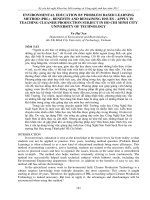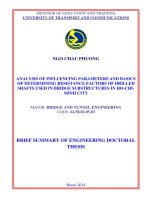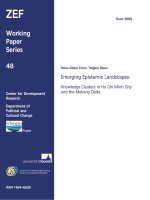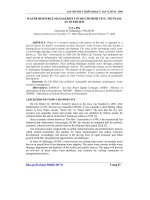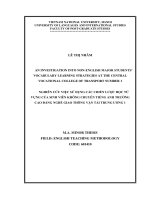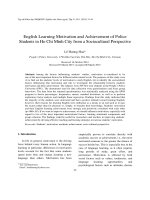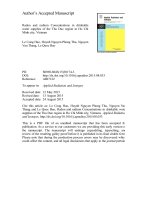an investigation into efl learners’ speaking problems and speaking strategies at college of foreign economic relations (cofer) in ho chi minh city
Bạn đang xem bản rút gọn của tài liệu. Xem và tải ngay bản đầy đủ của tài liệu tại đây (1.17 MB, 101 trang )
MINISTRY OF EDUCATION AND TRAINING
HO CHI MINH CITY OPEN UNIVERSITY
-------------------
PHAN THỊ MIÊN THẢO
AN INVESTIGATION INTO EFL LEARNERS’ SPEAKING PROBLEMS
AND SPEAKING STRATEGIES AT COLLEGE OF FOREIGN ECONOMIC
RELATIONS (COFER) IN HO CHI MINH CITY
ATHESIS SUBMITTED IN PARTIAL FULFILLMENT OF THE
REQUIREMENTS FOR THE DEGREE OF MASTER OF ARTS IN TESOL
Ho Chi Minh City, Year 2018
MINISTRY OF EDUCATION AND TRAINING
HO CHI MINH CITY OPEN UNIVERSITY
-------------------
PHAN THỊ MIÊN THẢO
AN INVESTIGATION INTO EFL LEARNERS’ SPEAKING PROBLEMS
AND SPEAKING STRATEGIES AT COLLEGE OF FOREIGN ECONOMIC
RELATIONS (COFER) IN HO CHI MINH CITY
ATHESIS SUBMITTED IN PARTIAL FULFILLMENT OF THE
REQUIREMENTS FOR THE DEGREE OF MASTER OF ARTS IN TESOL
Ho Chi Minh City, Year 2018
STATEMENT OF AUTHORSHIP
I certify that this thesis entitled “AN INVESTIGATION INTO EFL
LEARNERS’ SPEAKING PROBLEMS AND SPEAKING STRATEGIES AT
COLLEGE OF FOREIGN ECONOMIC RELATIONS (COFER) IN HO CHI
MINH CITY” is my own work.
Except where reference is made in the text of the thesis, this thesis does not contain
material published elsewhere or extracted from a thesis by which I have qualified for
or been awarded another degree or diploma.
No other person’s work has been used without due acknowledgment in the main text
of the thesis. This thesis has not been submitted for the award of any degree or
diploma in any other tertiary institution.
Ho Chi Minh City, 2018
PHAN THI MIEN THAO
ACKNOWLEDGEMENTS
I would like to express my sincere appreciation to people who have
constantly supported and helped me to accomplish this thesis.
My first debt of gratitude must go to my supervisor, Dr. Nguyen Dinh Thu
for his whole-hearted instructions, for invaluable experience he has shared with me,
his tremendous patience in giving me substantial feedback, and for all stimulating
conversations he has made with me at the very early stage of the development of
this work.
Next, I am thankful for all the participants for their enthusiastic cooperation
in the research.
Specially, I would like to extend my heart-felt gratitude to my loving family.
My two lovely daughters have been always besides me and given me their
unconditional love which has been my greatest inspiration and driving force during
my work.
Briefly, I am grateful to all the people without them my thesis would
certainly not have existed.
ABSTRACT
The increasing demand for good communicative skill in a globalized society
activates English speaking learning around the world. Specific to the Vietnamese
context, after many years of being much exposed to English, most of the students still
find it difficult to communicate effectively in real-life situations since they have not
yet possessed effective learning strategies in their speaking learning and they have
almost always encountered with a plenty of problems. Purposely, this study aimed at
discovering speaking learning strategies employed by the EFL third-year students at
College of Foreign Economic Relations (COFER) as well as their certain speaking
problems.
Theoretically, Oxford’s (1990) and Dörnyei and Scott’s (1995) were used as a basic
framework to carry out the study.
Methodologically, the study was carried out at the Faculty of Foreign Languages at
COFER with the participation of 82 students. Mixed-methods design was used for
collecting data, involving the two research instruments of the questionnaire and the
interview. While quantitative data obtained from the questionnaire were analyzed by
SPSS 20.0, interview results were thematically analyzed.
The findings of the study indicated that an overwhelming majority of the participants
frequently encountered with some negative factors and speaking problems in
association with linguistic problems, affective problems, or even insufficient time.
Pertinent to the used speaking learning strategies, the findings implied that a majority
of the EFL third-year students usually utilized both direct and indirect strategies. The
most frequently used strategies consisted of structuring or planning of ideas and
language input, [2] using dictionary for vocabulary learning, [3] compensating for
linguistic limitations by code-switching, nonverbal forms, synonyms, [4] paying
attention, [5] deeply breathing, and [6] asking for clarification. However, activating
prior knowledge, self-training language input (e.g. listening comprehension,
pronunciation), self-evaluating speaking performance were less frequently used
among many students.
Based on the research findings, the paper wrapped up with some pedagogical
implications for teachers and learners, and a recommendation for further study in the
line of research on speaking learning strategies and oral development.
TABLE OF CONTENTS
ACKNOWLEDGEMENTS............................................................................................................. 4
Chapter 1 : INTRODUCTION ....................................................................................................... 1
1.1
Background to the study.................................................................................................. 1
1.2
Statement of the problem ................................................................................................ 2
1.3
Objectives of the study ..................................................................................................... 4
1.4
Research questions ........................................................................................................... 4
1.5
Significance of the study .................................................................................................. 4
1.6
Organization of the thesis chapters ................................................................................ 5
Chapter 2 : LITERATURE REVIEW ........................................................................................... 5
Speaking skill .................................................................................................................... 6
2.1
2.1.1
Definition of speaking skill ...................................................................................... 6
2.1.2
Importance of Speaking Skill .................................................................................. 6
2.1.3
Aspect of speaking skill ............................................................................................ 7
2.1.3.1
Fluency ...................................................................................................................... 7
2.1.3.2
Accuracy ................................................................................................................... 8
2.1.3.3
Appropriacy .............................................................................................................. 8
2.2
Problem and factors affecting speaking performance .................................................. 9
2.3
Speaking strategies ......................................................................................................... 10
2.3.1 Definition............................................................................................................................ 11
2.3.2. Classifications ................................................................................................................... 12
2.3.3. Conceptual framework .................................................................................................... 17
Previous studies .............................................................................................................. 19
2.4
2.4.1. Overview of some previous studies ................................................................................. 19
2.4.2. Research gaps from the previous studies ....................................................................... 23
Summary ......................................................................................................................... 24
2.5
Chapter 3 : METHODOLOGY .................................................................................................... 24
3.1
Research setting.............................................................................................................. 24
3.2
Research design .............................................................................................................. 25
3.3
Overall research approach ............................................................................................ 26
3.3.1
Research design ...................................................................................................... 26
Research instruments............................................................................................. 27
3.3.2
3.3.2.1. Student questionnaire ................................................................................................... 28
3.4
Analytical framework .................................................................................................... 31
3.5
Summary ......................................................................................................................... 33
Chapter 4 : DATA ANALYSIS ..................................................................................................... 33
4.1
Questionnaire reliability analysis ................................................................................. 34
4.2
Thematic analysis ........................................................................................................... 35
4.3
Chapter summary .......................................................................................................... 63
Chapter 5 : DISCUSSION OF FINDINGS .................................................................................. 63
5.1
The speaking problems faced the EFL third-year students at COFER .................... 64
5.2
The speaking strategies used by the EFL third-year students at COFER ................ 66
5.3
Chapter summary .......................................................................................................... 72
Chapter 6 : CONCLUSIONS AND IMPLICATIONS ............................................................... 74
6.1
Summary of key findings ............................................................................................... 74
6.2
Justification of research methodology .......................................................................... 75
6.2.1. Strengths ....................................................................................................................... 75
6.2.2. Limitations .................................................................................................................... 75
6.3
Recommendations .......................................................................................................... 76
6.3.1. For students .................................................................................................................. 76
6.3.2. For teachers .................................................................................................................. 77
6.3.3. For further study .......................................................................................................... 77
6.4. Chapter summary ............................................................................................................... 78
REFERENCES ............................................................................................................................... 78
APPENDIX A.1 .............................................................................................................................. 83
APPENDIX A.2 .............................................................................................................................. 86
APPENDIX B.1 .............................................................................................................................. 89
APPENDIX B.2 .............................................................................................................................. 90
APPENDIX C ................................................................................................................................. 90
APPENDIX D ................................................................................................................................. 91
Chapter 1 : INTRODUCTION
1.1 Background to the study
Life today is extremely different from what it used to be. The increasing
demand for good communicative skill in a globalized society activates English
speaking learning around the world. English is spoken all over the world, that is, one
can communicate easily with both native speakers of English and non-native ones if
she/he is proficient in English. By virtue of this, being competent in oral
communication is a strong desire of all English learners. And speaking is a
fundamental skill that learners need to master in order to communicate effectively.
Phan (2014) shows that English is considered a “passport” to integrate with the world.
So, the EFL learners in general and the students at College of Foreign Economic
Relations (COFER) in particular are also aware of the importance of English speaking
learning. According to Brown and Yule (1983), in process of language learning,
speaking is highly evaluated to be important, yet the most difficult of the four skills.
However, many language learners, even after several years of studying English, still
find it very difficult to speak effectively. Brown (2001) believes that colloquial
language, reduced forms, performance variables, redundancy clusters, rate of
delivery, stress, rhythm and intonation are among the characteristics of speaking that
contribute to the difficulty of this skill. Moreover, in order for language learners to
manage oral communication, they need to produce connected speech, have
interaction ability, speak in different contexts, develop a balance between accuracy
and fluency, and talk about unfamiliar issues based on their knowledge (Lindsay &
Knight, 2006). Especially, one of possible reasons for speaking incompetency among
EFL learners is that students have not yet handled their speaking learning strategies
effectively. It is also inferred that learners can improve communicative proficiency
by developing an ability to use specific speaking strategies that enable them to
compensate for their target language deficiency (e.g. Richards & Renandya, 2002;
Mahripah, 2014).
1
Language learning strategies have been the heart of foreign language
education, attracting an ample of language theorists in the last few decades. The
aspects of learning strategies have been extensively concerned to get deep insight.
More recently, the focus of the research studies has been specified to each language
skill, and speaking as an illustration. In this domain of speaking skill, many studies
have been conducted on the theoretical bases of Oxford’s (1990) Strategy Inventory
for Language Learning (SILL). O’Malley and Chamot (1990) assert that speaking
strategies benefit language learners “in negotiating meaning where either linguistic
structures or sociolinguistic rules are not shared between a second language learner
and a speaker of the target language” (p. 43). The primary goal for any language
learners is that they are able to use the target language for their oral communication,
and finally become a competent speaker. Accordingly, Hedge (2000) convinces that
a competent speaker is the person who can use speaking strategies effectively to
compensate for speaking problems and to maintain his stream of verbal messages.
Alternatively stating, knowing and utilizing speaking learning strategies is of utmost
importance to the students for their oral language development.
In brief, speaking strategies are essential because they sufficiently provide
foreign language learners with valuable tools to communicate in the target language
in diverse contextual situations and help them to survive from a multiplicity of
speaking problems. Put it different, speaking learning strategies become vital to
develop the students’ language ability in order for them to be more self-sufficient and
active their own learning process.
1.2 Statement of the problem
In reality, there have been more and more communication courses in Vietnam
held to respond to leaners’ need of improving English communicative competence.
However, many Vietnamese learners have still found it difficult to speak English
fluently and accurately. After many years of being exposed to English in secondary
and high schools, and even at tertiary level (e.g., college), many of them still cannot
2
perform a simple and short conversation in English due to a multitude of factors.
Richards (2002) labeled several problems faced by poor learners in their English
speaking learning. For example, (1) students cannot sustain long conversations or
keep the interaction going; (2) students often encounter with communication
breakdowns and misunderstandings; (3) students’ lack of vocabulary and language
structures negatively impacts their oral production of ideas; (4) and students lack of
effective communication strategies. Sharing Richards’ ideas (2002), Rababa’h (2005)
added one more factor that hinders English speaking ability among EFL learners, that
is, inadequate strategic competence and communication competence. In other words,
they are deficient in being aware of and applying speaking strategies to facilitate their
oral production. Specific to the Vietnamese context, Nguyen and Tran (2015) listed
some barriers affecting Vietnamese learners’ speaking performance including
performance conditions (e.g., time pressure, planning, standard of performance and
amount of support), affective factors (e.g., motivation, confidence and anxiety), and
listening ability and feedback during speaking activities.
In order to reduce speaking problems and enhance oral performance, the
students need to manipulate the particular speaking learning strategies and use them
appropriately. Indeed, it is obvious that learners can improve their speaking ability
by developing learning strategies that help them to be more strategic and flexible in
overcoming speaking problems (Nakatani, 2005). In the same line, there is a positive
relationship between learning strategies and the students’ proficiency level
(Hismanoglu, 2000; Anderson, 2003). The greater variety and number of learning
strategies the students employ, the more language proficient they would be. In
general, Chamot (2004) claims that learning strategies contribute to the considerable
improvement on the less successful learners’ speaking performance. Given the fact,
the researcher is urged to discover the speaking problems faced by the EFL third-year
students at COFER and then how they used speaking strategies are explored, aiming
at tackling the recognized speaking problems, and reinforcing the use of the speaking
strategies to help EFL learners at COFER improve their speaking performance.
3
1.3 Objectives of the study
In this research, the focus deals with [1] the difficulties in speaking practice
that EFL learners at COFER might face, as well as [2] the speaking learning strategies
that EFL learners at COFER utilize for learning English speaking. Besides, the results
of this research would help raise their awareness of using learning strategies in their
oral production in order to survive them from different speaking problems.
1.4 Research questions
The objectives were achieved based on finding answers to the two following
research questions:
Research question 1: What problems do the EFL students at COFER confront
in their EFL speaking learning?
Research question 2: How do the EFL learners at COFER use speaking
strategies for their speaking learning?
1.5 Significance of the study
The current study investigates the current speaking learning strategies and the
difficulties that the EFL learners have met during the process of learning English at
COFER. The results of this study may help the EFL learners to find some useful
speaking learning strategies to improve their speaking ability.
The study seeks the significant results for both the teachers and the students at
COFER. Firstly, through the results of the study, the teachers can understand the
difficulties affecting the EFL students’ speaking learning. Then, the teachers can
broaden their students’ knowledge of learning strategies and train them how to apply
appropriate learning strategies to rescue them from the existing speaking problems
and reinforce their oral performance. Secondly, the findings emerged from the study
also support the students to find out the useful learning strategies for their speaking
learning, leading to their increased confidence and better learning outcomes. Finally,
the researcher also expects the learners’ oral communication can be improved in the
4
classroom as well as in the real life after concentrating the learning strategies in the
study.
1.6 Organization of the thesis chapters
In this study, there are five chapters listed as follows:
Chapter 1 includes the background to the study, statement of the problem,
purpose of the study, research questions, the significance of the study and the
organization of the thesis.
Chapter 2 reviews the literature as well as theories relevant to the topic of the
study. This chapter mentions the definitions and the problems of learning speaking
skill, and learning strategies and speaking strategies, and some previous studies.
Chapter 3 shows the study methodology which describes participants, research
setting, methods of data collection and data analysis.
Chapter 4 and 5 analyze the collected data and discuss the findings from the
data analysis respectively.
Chapter 6 consists of the conclusions of the study and some recommendations
which help teachers solve the problems in teaching English speaking and help
learners find the suitable learning strategies to improve their oral communication
during learning speaking skill, followed by limitations and suggestions for further
research.
Chapter 2 : LITERATURE REVIEW
The aim of this chapter is to present the theoretical fundamentals used to pillar
this study. The chapter opens with a brief literature review on speaking, its aspects
5
and problems. The speaking learning strategies are then emphasized, consisting of
types and classifications. Afterwards, some relevant empirical studies which have
examined the relationships between use of speaking learning strategies and EFL
speaking performance are explored here. From what have already been conducted in
association with this arena, the last part elucidates some research gaps to situate the
current study.
2.1 Speaking skill
2.1.1 Definition of speaking skill
Speaking is one of the most basic skills of any language learners. In fact,
people use this productive skill for their lives and work or study. Ur (1996) agreed
that speaking is viewed as the most important skill among four language skills.
Theorists have defined the term “speaking” in various ways. As Spratt,
Pulverne and William (2011) describe, “speaking is one of the four language skills:
reading, writing, listening and speaking, […] are productive skills” (p. 48). It is
implied that speaking involves yielding the language in lieu of receiving it solely.
Similarly, Brown (1994) defines speaking as a complex interactive streamline of
making meaning by ways of producing, receiving, and processing information.
Bygate (1987) defined speaking as the production of auditory signals to give different
verbal responses to listeners. It is regarded as “combining sounds systematically to
form meaningful sentences” (Leong & Ahmadi, 2017, p. 35). Besides, speaking is
also subject to physical paralinguistic features (Harmer, 2007). In speaking, speakers
try out new vocabulary and develop working knowledge of language form and
structure; at the same time, facing clues like intonation and gesture also contribute to
understanding among communicators (Dawes, 2008). In general, speaking, like any
other language skills, is more complicated than it seems at first.
2.1.2 Importance of Speaking Skill
6
In leaning language, it is rather uneasy to make a conclusion on the most
important skill among listening, speaking, reading and writing. However, speaking is
deemed to be the closest to the goal of language teaching; that is, speaking
performance. Ur (1996) considers that of all the four skills, speaking seems intuitively
the most important one because the ability to speak skillfully provides the learners a
favorable condition to establish and maintain relationships, to negotiate with others.
In specific, Carnegie (1977) assumed that business, social, and personal satisfaction
depend heavily on people’s ability to communicate clearly to others about their
identity, desire and beliefs. Nunan (1991) views good speaking performance is the
most important aspect of acquiring a foreign language, which is assessed by the
ability to sustain a conversation in the target language. In short, speaking plays a
crucial part in social life and is a dispensable skill for any language learner.
2.1.3 Aspect of speaking skill
In oral learning, Hymes (1972) believed that EFL learners are required to
know both the linguistic knowledge (i.e. accuracy) and the culturally appropriate
ways (i.e. appropriacy) to interact with others in diverse situations and which
facilitates their smooth oral stream (i.e. fluency). In the same vein, Harmer (2001)
posits that speaking skill has two different aspects including accuracy and fluency.
To develop their communicative competence, speakers should reinforce their
grammatical competence, discourse competence, sociolinguistic competence, and
strategic competence (Canale & Swain, 1980).
2.1.3.1 Fluency
Fluency is the speakers’ ability to utter in an understandable way so that
communication breakdown does not occur (Hughes, 2002). Along with it, Hedge
(2000) depicts that fluency is the ability to make a coherent speech by linking the
7
words and phrases logically, pronouncing the sounds clearly, and utilizing stress and
intonation suitably.
To ensure fluent oral production, speakers need to enhance their strategic
competence, which refers to the ability to know when and how to initiate and maintain
the conversation and how to minimize communication breakdowns and
comprehension barriers (Richards & Renandya, 2002). It can be implied that speakers
must be consciously aware of speaking strategies and apply them effectively.
2.1.3.2 Accuracy
Accuracy pertains to the correctness and the fullness of language forms when
speaking in association with grammatical structures, vocabulary, and pronunciation
(Mazouzi, 2013). That is considered as grammatical competence of an EFL speaker
in their oral production. Grammatical competence helps speakers to manipulate and
comprehend English language patterns correctly. Besides, in order to communicate
well, speakers are asked to perceive meaning connections from previous sentences to
following sentences, indicating some relationships about time, cause and effects, etc.
(Richards & Renandya, 2002). Clearly, discourse competence is also of great
importance to any speakers when this element facilitates accuracy of what they are
uttering.
2.1.3.3 Appropriacy
Aside from speaking accurately and fluently, speakers are required to say
appropriately. According, a speaker’s sociolinguistic competence enables this person
to differentiate appropriate exchanges, how to ask questions during interaction, and
how to respond nonverbally according to the objective of the interaction (Richards &
Renandya, 2002). Put it simply, when speaking, learners should take cultural issues
and social knowledge into account.
8
2.2 Problem and factors affecting speaking performance
There are multiple problems which can come across in developing speaking
performance among students. Nguyen and Tran (2015) posit that learners’ speaking
performance are often affected by factors like affective elements, listening ability,
and feedback during speaking activities as well as performance conditions. First of
all, oral productions of EFL learners also can be impacted by their affective states
such as motivation, self-confidence, and anxiety (Oxford, 1990). For example, the
study of Leong and Ahmadi (2017) proved that learners with a low self-esteem,
higher anxiety, and low motivation have serious difficulties in building up speaking
ability. Secondly, learners are unable to develop their communicative competence
until they improve their listening ability. Indeed, any communicators have the dual
role of listeners and speakers, in which they have to listen what is uttered from others
and then reply compatibly. Thirdly, speaking performance is also pertinent to the
feedback during speaking activities. And, the feedback relies on the lesson stages, the
task types, and the error types. Finally, Nation and Newton (2009) point out some
performance conditions can directly influence learners’ speaking performance such
as time pressure, planning, and the amount of support.
Additionally, Mahripah (2014) reveals that EFL learners’ speaking skill is
influenced by some linguistic components of language including phonology, syntax,
and vocabulary. Beside linguistic knowledge, topical knowledge makes an ample
contribution to learners’ speaking performance (Bachman & Palmer, 1996). By
definition, these authors describe topical knowledge as the speakers’ knowledge of
related topical information, which enables students to apply language with respect to
the world in which they live. Thus, it is imperative for speakers to exploit both
language and background knowledge when orally producing English utterances.
Along with this, according to Ur (1996), one of many factors that hamper EFL
students’ speaking skill development is their low or uneven participation.
Alternatively saying, only one participant can talk through a time due to large classes
9
and the tendency of some learners to be prominent, while others tend to speak little
or not at all.
In some cases, speaking ability is also negatively impacted when some learners
try to use first language in learning speaking in foreign language because it is very
easy for them (Ur, 1996; Nguyen & Tran, 2015). Harmer (1991) specifies some
reasons why learners use first language in their speaking classes. To begin with, when
teachers ask their learners to talk about a topic that they do not have sufficient
knowledge, they may try to use their mother tongue. Secondly, using first language
is very natural for learners to use. Thirdly, learners will automatically use their first
language to clarify something to their interlocutors when their partners do not
understand.
In sum, EFL learners face a plenty of obstacles that negatively impact their
speaking performance including some linguistic problems (e.g. low listening ability,
mispronunciation, lack of grammatical and lexical knowledge, etc.), shortage of
topical knowledge, affective hindrances (e.g. low motivation, high anxiety, high
apprehension, etc.). To cope with these frequently faced speaking problems, EFL
learners are required to employ appropriate speaking learning strategies with a view
to becoming a competent speaker in conjunction with accuracy, fluency and
appropriacy aspects.
2.3 Speaking strategies
Among the four language skills, speaking is believed to be the most important
and difficult skill in mastering a foreign language, which encompasses several
components such as grammar, vocabulary, pronunciation, ideas, and other
paralinguistic elements. One of the aspects that are involved in the process of
developing speaking skill is the language learning strategies used by the learners
themselves. In this section, the researcher summarizes some definitions and
classifications of language learning strategies in the milieu of developing speaking
skill.
10
2.3.1 Definition
Researches on language learning strategies have launched in 1960s. O’Malley
and Chamot (1990) define that “learning strategies are special thoughts or behaviors
that individuals use to help them comprehend, learn, or retain new information” (p
.1). It means that language learning strategies are certain activities, behaviors or
techniques adopted by students for reinforcing their language skills, recalling and
deploying what they have recently learned, mostly in a pre-determined way.
In the same vein, Oxford (1990) also points out learning strategies are
particular actions done by learners to support their own learning, to generate their
learning easier, faster, more fantastic, more strategic, and more efficient. By
exploiting the appropriate strategies, the process of learning the language improves
considerably. In other words, appropriate language learning strategies are used by
learners to help them grasp new information better and to help them solve language
problems. Later, Cohen (1998) posits that language learning strategies are “learning
processes which are consciously selected by the learners and which may result in
actions taken to enhance the learning or use of a second or foreign language, through
the storage, retention, recall, and application of information about that language” (p.
4).
Specific to the domain of speaking skill learning, speaking strategies help
students become more strategic and active in oral productions and rescue them to
overcome speaking problems such as linguistic barriers or lack of ideas, etc. Speaking
strategies are referred to “communicative strategies, communication strategies,
conversation skills or oral communication strategies, used by students to solve any
communication problem when speaking in English” (López, 2011, p. 3). As what
Hedge (2000) claims, a competent speaker knows how to make use of speaking
strategies, which “come into play when learners are unable to express what they want
to say because they lack the resources to do so successfully” (p. 52). These verbal
and non-verbal strategies (e.g. verbal circumlocution, clarification, non-verbal
11
gestures, etc.) may be exerted to compensate for a breakdown in communication or
for unknown words or topics, and they may also be used to enhance effective
communication.
2.3.2. Classifications
O’Malley and Chamot (1990) describe that in the language learning process,
there are three different types of strategies, that is, (i) metacognitive strategies, (ii)
cognitive strategies, and (iii) socio-affective strategies. Likewise, White (1993) also
classifies learning strategies in such three types. In specific, metacognitive strategies
involve planning; monitoring and evaluating comprehension, whilst cognitive
strategies are used to manipulate information, and socio-affective strategies are
related to the ways that learners decide to interact with others.
More specifically, Oxford (1990) differentiates language learning strategies
into six groups: (i) memory strategies, (ii) cognitive strategies, (iii) compensation
strategies, (iv) affective strategies, (v) metacognitive strategies, and (vi) social
strategies. These six strategy groups are categorized into two major classes, namely
direct strategies and indirect strategies (see Table 2.1). Direct strategies consist of
memory strategies, cognitive strategies and compensation strategies, while indirect
strategies comprise metacognitive strategies, affective strategies and social strategies.
In brief, Oxford proclaims that these six language learning strategy groups enable the
language learners to communicate competently.
12
Table 2.1: Oxford’s Language Learning Strategy Scheme (1990, pp. 18-21)
Language Learning
Description
Strategies
Memory strategies
“Creating links mentally, applying sounds and images,
reviewing well, and employing action”.
Cognitive strategies
Practicing, reviewing and sending messages, analyzing
and reasoning, and creating structure for input and
output”.
Compensation
“Guessing intelligently, and overcoming limitations in
strategies
writing and speaking”.
Metacognitive
“Centering one’s learning, planning and arranging
strategies
one’s learning, and evaluating one’s learning”.
Affective strategies
“Lowering one’s anxiety, encouraging oneself, and
taking one’s emotional temperature”.
Social strategies
“Asking questions, cooperating with others and
empathizing with others”.
The taxonomy of Dörnyei and Scott (1995) not only refers to strategic
behaviors, but also involves the three main categories, namely direct strategies,
indirect strategies and interactional strategies. This scheme is presented in Table 2.2.
Table 2.2: Dörnyei and Scott’ (1995) taxonomy of speaking strategies
Categories
Strategic speaking behaviors
13
Direct strategies
Message abandonment; reduction; replacement;
circumlocution; restructuring; code switching; self-repair;
self-rephrasing
Indirect strategies
Verbal strategy markers, stimulating understanding,
repetition
Interactional
Requesting clarification; requesting repetition; requesting
strategies
confirmation; Inference; expressing non-understanding,
understanding check; own-accuracy check, asking for
assistance
As can be seen from Table 2.1 and Table 2.2, Dörnyei and Scott’ (1995) direct
strategies refer to the use of an alternative method, which is more manageable and
self-contained to convey the intended meaning. Oxford’s (1990) subcategory of
memory, cognitive and compensation strategies reflects this, which are the members
of the main category of direct strategies. What is more, indirect strategies, according
to Dörnyei and Scott (1995), offer support for mutual understanding, such as making
use of verbal makers or stimulating understanding to sustain the conversation.
Similarly, Oxford (1990, p.135) attributed indirect strategies to those that support
learning without the direct involvement of the target language. Interactional
strategies, places its primary emphasis on the cooperative conduction of problemsolving exchanges (e.g. providing clarification, requesting confirmation or asking for
help). This is also comparable to Oxford’s (1990) definition of social strategies.
The present study is based on Oxford’s (1990) framework of language learning
strategies and the specific strategic speaking behaviors framed by Dörnyei and Scott
(1995). Indeed, Oxford’s classification aimed at overall language learning but this
study only focuses on the speaking learning. Thus far, Dörnyei and Scott’s (1995)
taxonomy which is presumed to be more problem-orientated and process-based with
14
specific strategic behaviors is also referred. Table 2.3 below presents the framework
of speaking strategies used in this study.
Table 2.3: The framework of speaking strategies used in this study
Categories
Description
Strategic speaking strategies
Memory
Structuring the
Putting a new word in a meaningful context for
strategies
process of reviewing; easier memory and use;
building mental
links; retrieving.
Revising previously learned knowledge in
English;
Thinking about new words with known words
(in sound, meaning and function) before
speaking
Imagining situation that speakers want to talk
about to help guide them
Cognitive
Enhancing learning
strategies
through various ways songs and films or formal exercises.
(practicing,
repeating,
translating, deductive
reasoning).
Practicing listening and pronunciation through
Structuring some ideas in mind before
speaking
Using the dictionary to prepare some needed
vocabulary for communicative activity
Compensation
Overcoming
Making prediction by contextual clues and
strategies
limitations; guessing
linguistic clues;
based on clues
Switching to mother tongue;
Using mine and gestures;
Use a synonym;
15
Metacognitive
Managing learning
Set a goal or objective for a communicative
strategies
by centering,
task
planning, organizing,
evaluating, or
Paying attention while speaking
monitoring learning
Evaluating learning outcomes
Affective
Reducing anxiety;
Taking deep breath or using laughter
strategies
making positive
statements; viewing
Encouraging oneself
risks and mistakes
Exchanging feelings to other speakers
Social
Asking others for
Asking someone for mistake correction
strategies
help; cooperating
with others;
Asking for clarification
enhancing mutual
Practicing English with peers or proficient
understanding
users
Becoming aware of others’ thoughts and
feelings
In general, based on the six sub-groups of language learning strategies
proposed by Oxford (1990) and specific strategic reading strategies recommended by
Dörnyei and Scott’s (1995), it is posited that all these strategies, no matter whether
they are direct or indirect, interact with each other. It is meant that in speaking
learning, students need to use these strategies flexibly and skillfully. Each of strategy
categories contributes to the quality of speaking performance among EFL learners as
follows:
1. Memory strategies imply any set of techniques which are created to facilitate
one’s memorization, enable the transfer of information to long-term memory
and recalling it for communication (Bölükbaş, 2013). These strategies can
16
simply involve the things that we normally do in our daily lives such as making
questions by ourselves to remind the important things.
2. Cognitive strategies help students to develop the thinking skills that make
them strategic and flexible (Ellis, 1997), which improve speakers’ knowledge
and their understanding of linguistic system.
3. Compensation strategies enable student speakers to solve difficult situations
that obstruct communication; for example, making logical guesses,
overcoming language limitations during producing language and using body
language (Bölükbaş, 2013).
4. Metacognitive strategies enable the students to plan, monitor and evaluate
their own learning process (Bölükbaş, 2013). In the same fashion,
metacognitive strategies “help learners to regulate their own cognitive abilities
and to focus, plan, and evaluate their progress as they move toward
communicative competence” (Gani, Fajrina, & Hanifa, 2015, p. 21). O’Malley
and Chamot (1990) claims that these strategies can be used to plan for learning
(e.g. for speaking activities in this study), monitoring production and
comprehension and finally evaluation after accomplishing an activity.
5. Affective strategies help “develop self-confidence” (Gani, et al., 2015, p. 21),
“control their feelings, motivation and attitudes related with learning”
(Bölükbaş, 2013, p. 57). The latter author exemplifies some examples of
affective strategies such as “reducing anxiety, encouraging or rewarding
oneself, controlling his/her own emotional changes by listening to
himself/herself, keeping a diary of language learning or sharing feelings with
others” (p. 57).
6. Social strategies are useful for interaction with others, especially in speaking
skill (Bölükbaş, 2013). These strategies can provide increased interaction and
more empathetic understanding for speakers.
2.3.3. Conceptual framework
17
